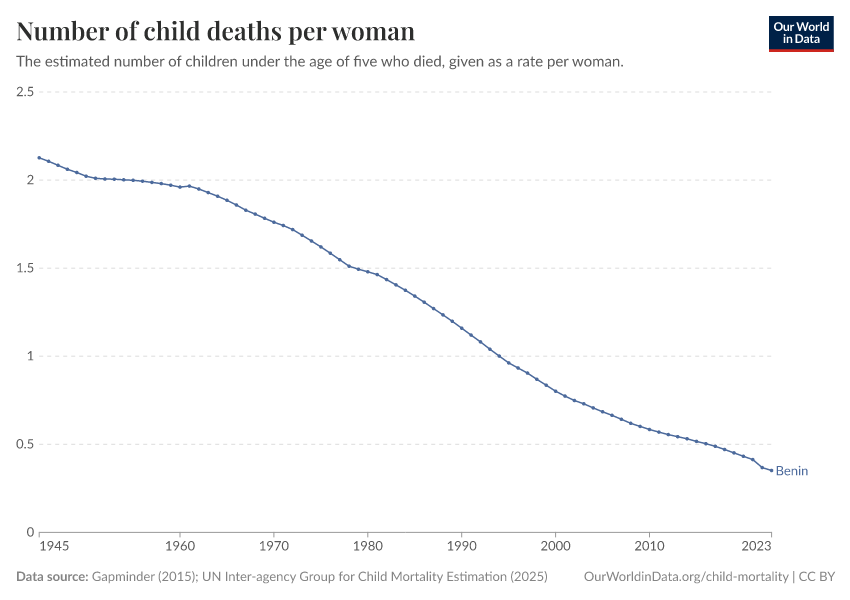Child mortality rate

What you should know about this indicator
- What could be more tragic than the death of a young child? Child mortality, the death of children under the age of five, is still extremely common in our world today.
- The historical data makes clear that it doesn’t have to be this way: societies can protect their children and reduce child mortality to very low rates. For child mortality to reach low levels, many things have to go right at the same time: good healthcare, good nutrition, clean water and sanitation, maternal health, and high living standards. We can, therefore, think of child mortality as a proxy indicator of a country’s living conditions.
- The chart shows our long-run data on child mortality, which allows you to see how child mortality has changed in countries around the world. It combines data from two sources: Gapminder and the UN Inter-agency Group for Child Mortality Estimation (UN IGME).
- Gapminder provides estimates of child mortality rates from 1800 to 2015. The full list of sources used can be found in their documentation.
- UN IGME provides estimates of child mortality rates for some countries from 1932 onward.
- For years where data from both sources is available, we prioritize the UN IGME data. See this page for more details on which source is used for each data point.
- This indicator is calculated as the number of children under the age of five who died in a given year, divided by the number of newborns in that year.
Related research and writing
What you should know about this indicator
- What could be more tragic than the death of a young child? Child mortality, the death of children under the age of five, is still extremely common in our world today.
- The historical data makes clear that it doesn’t have to be this way: societies can protect their children and reduce child mortality to very low rates. For child mortality to reach low levels, many things have to go right at the same time: good healthcare, good nutrition, clean water and sanitation, maternal health, and high living standards. We can, therefore, think of child mortality as a proxy indicator of a country’s living conditions.
- The chart shows our long-run data on child mortality, which allows you to see how child mortality has changed in countries around the world. It combines data from two sources: Gapminder and the UN Inter-agency Group for Child Mortality Estimation (UN IGME).
- Gapminder provides estimates of child mortality rates from 1800 to 2015. The full list of sources used can be found in their documentation.
- UN IGME provides estimates of child mortality rates for some countries from 1932 onward.
- For years where data from both sources is available, we prioritize the UN IGME data. See this page for more details on which source is used for each data point.
- This indicator is calculated as the number of children under the age of five who died in a given year, divided by the number of newborns in that year.
Sources and processing
This data is based on the following sources
How we process data at Our World in Data
All data and visualizations on Our World in Data rely on data sourced from one or several original data providers. Preparing this original data involves several processing steps. Depending on the data, this can include standardizing country names and world region definitions, converting units, calculating derived indicators such as per capita measures, as well as adding or adapting metadata such as the name or the description given to an indicator.
At the link below you can find a detailed description of the structure of our data pipeline, including links to all the code used to prepare data across Our World in Data.
Reuse this work
- All data produced by third-party providers and made available by Our World in Data are subject to the license terms from the original providers. Our work would not be possible without the data providers we rely on, so we ask you to always cite them appropriately (see below). This is crucial to allow data providers to continue doing their work, enhancing, maintaining and updating valuable data.
- All data, visualizations, and code produced by Our World in Data are completely open access under the Creative Commons BY license. You have the permission to use, distribute, and reproduce these in any medium, provided the source and authors are credited.
Citations
How to cite this page
To cite this page overall, including any descriptions, FAQs or explanations of the data authored by Our World in Data, please use the following citation:
“Data Page: Child mortality rate”, part of the following publication: Saloni Dattani, Fiona Spooner, Hannah Ritchie, and Max Roser (2023) - “Child and Infant Mortality”. Data adapted from United Nations Inter-agency Group for Child Mortality Estimation, Gapminder, Gapminder based on UN IGME & UN WPP, United Nations, Various sources. Retrieved from https://archive.ourworldindata.org/20251023-195030/grapher/children-died-before-five-per-woman.html [online resource] (archived on October 23, 2025).How to cite this data
In-line citationIf you have limited space (e.g. in data visualizations), you can use this abbreviated in-line citation:
Gapminder (2015); UN Inter-agency Group for Child Mortality Estimation (2025) – processed by Our World in DataFull citation
Gapminder (2015); UN Inter-agency Group for Child Mortality Estimation (2025) – processed by Our World in Data. “Child mortality rate – Gapminder; UN IGME – Long-run data” [dataset]. United Nations Inter-agency Group for Child Mortality Estimation, “United Nations Inter-agency Group for Child Mortality Estimation”; Gapminder, “Child mortality rate under age five v7”; Gapminder based on UN IGME & UN WPP, “Under-five Mortality v11”; United Nations, “World Population Prospects”; Gapminder, “Babies per woman (total fertility rate) v12”; Various sources, “Population” [original data]. Retrieved December 5, 2025 from https://archive.ourworldindata.org/20251023-195030/grapher/children-died-before-five-per-woman.html (archived on October 23, 2025).